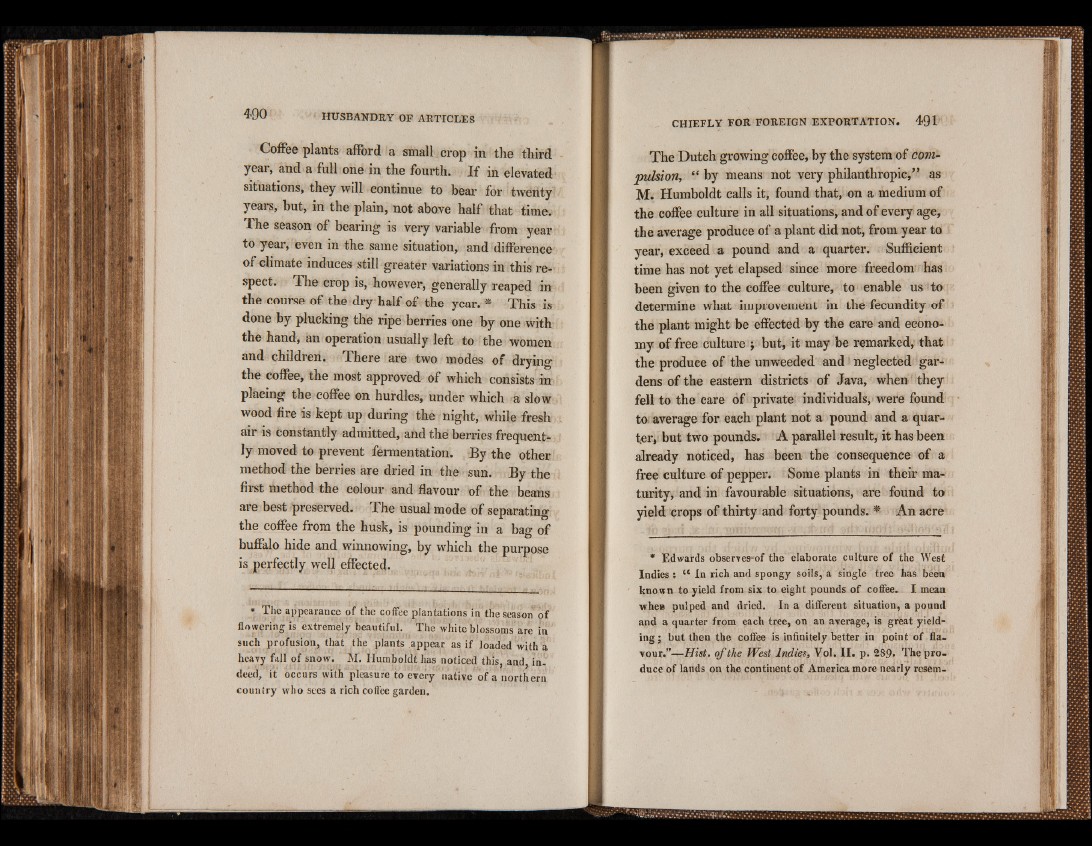
Coffee plants afford a small crop in the third
year, and a full one in the fourth. If in elevated
situations, they will continue to bear for twenty
years, but, in the plain, not above half that time.
The season of bearing is veiy variable from year
to year, even in the same situation, and difference
of climate induces still greater variations in this respect.
The crop is, however, generally reaped in
the course of the dry half of the year. * This is
done by plucking the ripe berries one by one with
the hand, an operation usually left to the women
and children. There are two modes of drying
the coffee, the most approved^ of which consists in
placing the coffee on hurdles, under which a slow
wood fire is kept up during the night, while fresh
air is constantly admitted, and the berries frequently
moved to prevent fermentation. By the other
method the berries are dried in the sun. By the
first method the colour and flavour of the beans
are best preserved. The usual mode of separating:
the coffee from the husk, is pounding in a bag of
buffalo hide and winnowing, by which the purpose
is perfectly well effected.
* The appearance of the coffee plantations in the season of
flowering is extremely beautiful. The-white blossoms are in
such profusion, that the plants appear as if loaded with a
heavy fall of snow. M. Humboldt has noticed this, and, indeed,
it occurs with pleasure to every native of a northern
country who secs a rich coffee garden.
The Dutch growing coffee, by the system of compulsion,
“ by means not very philanthropic,” as
M. Humboldt calls it, found that, on a medium of
the coffee culture in all situations, and of every age,
the average produce of a plant did not, from year to
year, exceed a pound and a quarter. Sufficient
time has not yet elapsed since more freedom has
been given to the coffee culture, to enable us to
determine what improvement in the fecundity of
the plant might be effected by the care and economy
of free culture ; but, it may be remarked, that
the produce of the unweeded and neglected gardens
of the eastern districts of Java, when they
fell to the care of private individuals, were found
to; average for each plant not a pound and a quarter,
but two pounds. A parallel result, it has been
already noticed, has been the consequence of a
free culture of pepper. Some plants in their maturity,
and in favourable situations, are found to
yield crops of thirty and forty pounds. * An acre
* Edwards observes-of the elaborate culture of the West
Indies : “ In rich and spongy soils, a single tree has been
known to yield from six to eight pounds of coffee. I mean
when pulped and dried. In a different situation, a pound
and a quarter irom each tree, on an average, is great yielding
; but then the coffee is infinitely better in point of flavour.”—
Hist, o f the West Indies, Vol. I I . p. 289. The produce
of lands on tfle continent of America more nearly resem